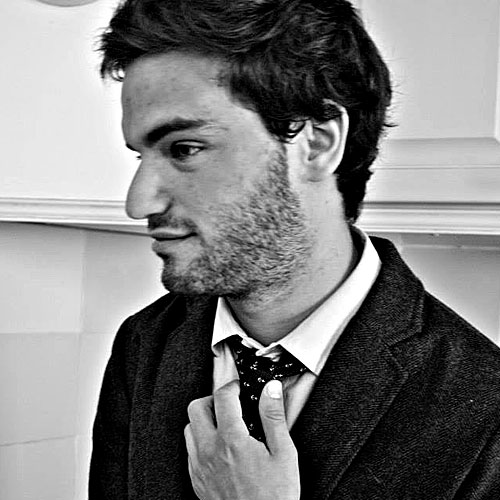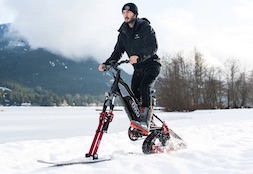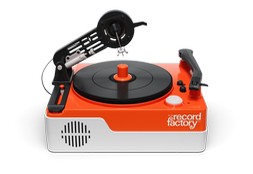By the grill, he stands.
Wearing a baseball hat, stressed and sweat-stained, a faded concert t-shirt and a pair of Wrangler jeans, light-washed and a little loose around the thighs. He has a well-shorn beard or, depending on his age, a sculpted goatee, salted with grey. Streaks of sunscreen, applied sloppily under his eyes and across the bridge of his nose and on the thin arches of his ears, glisten in the daylight. Somewhere in the distance, Paul McCartney croons.
“Dad,” his daughter says, tugging at his pant leg. “I want a hamburger.”
He picks her up and cradles her on his forearm. His smile reveals: white teeth; the coterie of nascent wrinkles etched into his face; a deep well of patience. You can see the look of adoration in his eyes, as he stares down at her, absentmindedly flipping the meat on the grill. They practically sparkle. He is the epitome of the family man, the anodyne guy with a depleted store of testosterone, pre-Viagra but give it a few more years, progressive enough (he’s trying), one of the quote-unquote “good ones,” a classic case of someone-you-bring-home-to-mom—though, if he’s here, now, barbequing, it’s likely some lucky lady already has.
Critically, he is not called father; nor is he daddy. He is dad.
——
But who is “dad,” really?
In the above portrait, we can see his silhouette—a little thick around the midsection—yet the specifics remain clear. Though perhaps he is necessarily vague; perhaps that is key to his appeal.
The “dad” of which I speak is the “dad” of “dad jeans,” “dad jokes,” “dad bod,” “dad rock,” “dad hats," "dad shoes," and other nouns (or products) that attach themselves to such a meaningful, meaningless modifier. He is late-capitalism “dad”: a family member-cum-marketing term.
In the fashion space, the trend towards dad-ness seems to be a natural evolution of the normcore movement. The portmanteau, which was popularized by the trend forecasting group, K-Hole, in 2013, connotes images of fashionistas dressed like tourists, in Birkenstocks and stonewash jeans, Patagonia fleeces and cheap caps, generic (or geriatric) sneakers, bucket hats and Crocs. Part of its appeal, certainly, was its irony—a self-aware jab at the arbiters of high fashion, and a calculated effort to subvert entrenched notions of “cool.” But it was also a way of eschewing the ever-changing demands of the fashion world. Rather than define yourself by what you wear—this brand or that—you could define yourself by what you didn’t. You could embrace togetherness in a moment when individuality had, for those who grew up with the internet, become something of a fallacy, anyway.
Of course, as was the case with fringe trends throughout history, the mainstream soon consumed the elements of normcore, digested them and rebranded the clothes the masses had been wearing for decades as high-end. (One need only look at the ugly sneakers of Balenciaga, or pretty much anything from Acne Studios, to see its predictable terminus.) The ultimate irony of the movement is that it became fashionable; that kitsch became cool.
“Normcore” has since become somewhat of a dirty word, associated with the same grating irony and preciousness as “hipster.” “Dad,” however, has no such associations—at least not yet. It’s a branding term, yes; but it also stems from and conjures images of a person who is impervious and oblivious to trends. By wearing clothing delineated as such, you may not feel like you’re mimicking the faceless trendspotter you’ve built up in your head; it’s less ironic than normcore, more straightforward and honest. It’s a word—and an assemblage of products—that’s insulated from cynicism because it’s representative is perceived as timeless and fixed, even if it’s really imprecise and shifting; it feels innocently outdated, even if it’s modern. In the realm of fashion, “dad” carries an air of cluelessness that belies how fundamentally in-the-know it is.
“Dad jeans” are perhaps the most visible holdover from (or manifestation of) normcore, though there’s been some debate over what actually qualifies. In 2013, the menswear arbiters over at GQ called out The New York Times for their depiction of the trend: “The jeans that the Times are pointing out are trending? They’re light washed jeans with slim cuts that skim your leg, as opposed to the skin hugging, dark, rough raw denim stuff that this new wave of jeans is a reaction to.” But they’re not technically dad jeans, which are “higher than the highest rise you’ve ever encountered” and, basically, “sweatpants in denim form.” In other words: quote-unquote “real” dad jeans mean hands-on-his-hips Jerry Seinfeld, not some thirtysomething dude with a legit sense of style jamming out with his girlfriend at a Stephen Malkmus concert.
As with most trends, there’s some debate over whether or not it’s actually over. GQ might say it is, though Kanye West seems to have made it more or less the basis for his designs; Who What Wear might say it isn’t, at least not for women. Urban Outfitters, the bastion of mass-market hipsterdom, still sells a pair they deign to call a Dad Jean, but it’s far more in line with the simply light-washed ‘90s look described in the Times article than what we may consider actual dad jeans (though I’ve seen those, too). The bottom line is, nobody’s going to agree on what qualifies jeans as “dad”; the vague specificity of the term is precisely what allows marketers and editors to label so many concrete products as such, with complete sartorial impunity. Suffice to say, you tend to know “dad jeans” when you see them.
The same can be said of “dad hats,” which, thanks to artists like Mac DeMarco and Tyler, the Creator, are increasingly en vogue. Elle described them thusly in a trend piece from 2016: “What is a dad hat? Simply put, a baseball cap. But not a snapback, flatbrim, or fitted. A dad hat is a baseball cap that's canvas or cotton and has a slightly curved brim (not too curved, though) and is probably a little oversized on the wearer. Unless, of course, you're actually a dad—then it probably fits you perfectly.”
They cite Drake, Barack Obama and North West as prominent wearers. Advising readers on how to wear them, Elle suggests you “just put it on your head. They aren't supposed to match your look— that's the genius of dad hats.” The lesson here being: real dads don’t know—or care—about matching their hats to their outfit. (And the subtler lesson here being: wait, people actually match their outfits to their hats?)
Again, the folks at GQ seem to have a slightly different conception of the dad hat. Their guide from April includes some hats that would certainly qualify under Elle’s more female-friendly definition—slightly curved brim, somewhat oversized—while also highlighting those with a wide brim (albeit, a short wide brim). The commonality one gleans from their selections is a certain generic-ness; they seem designed to approximate the sort of hat you, or your dad, would randomly pick up at a souvenir gift shop—less for style, more for shade. This is essentially normcore, with the exception that the notion of “dad” makes the wearer complicit in a very particular kind of blandness. It implies a specific nonchalance and calculated ambivalence towards style, inextricable from the cultural undertones of the term.
Most of all, both the hats and the jeans carry the backyard-grass-stain of "cool" without any of the edge, cynicism, subversiveness or rebellion, and only a smidgen of the irony, that are the standard historical signifiers of the word. Sentimentalized by nostalgia—many of the people buying “dad hats” or “dad jeans” grew up or came of age in the ‘90s, the era from which they sprung—the style is uniquely sincere and harmless, gentle and goofy.
——
Which brings us, warily, to the “dad bod.” In the extended “dad” universe, the bod is the flabby center where the sartorial and cultural associations of the word meet.
The term first broke into the mainstream vernacular when Mackenzie Pearson, a 19-year-old sophomore at Clemson University, penned a brief essay for Odyssey, entitled: “Why Girls Love the Dad Bod.”
“The dad bod is a nice balance between a beer gut and working out,” Pearson wrote. “The dad bod says, ‘I go to the gym occasionally, but I also drink heavily on the weekends and enjoy eating eight slices of pizza at a time.’ It's not an overweight guy, but it isn't one with washboard abs, either.”
Reasons she includes for women “loving” the dad bod include “better cuddling,” “good eats” and the fact that “it doesn’t intimidate us.” She explained the term further to Amanda Hess, in an interview for Slate: “It’s a boy-next-door look. He’s the kind of person you go on a hike with, and then at the end of the day, you eat pasta and lay in bed and watch a movie.”
Physically, the “dad bod” describes a dude likely to wear the kind of clothes attributed to dads, like looser-fitting jeans and baseball hats. But it also carries an emotional significance: the “dad bod” represents the kind of guy you can feel comfortable around, the kind of guy who’s soft and fuzzy (literally and figuratively), the kind of guy you can lean on. He’s a not-unsexy counter to the edgy bad boy type, a sweatshirt-wearing, SUV-driving John to a leather-clad, motorcycle-riding Johnny. He’s the guy who doesn’t even make it into the romantic comedy, because he’s figuring out how to deal with his relationship issues in a relatively un-dramatic way, somewhere off-screen. To sum it up: he’s the platonic dad ideal in sexualized boy form.
“A man is perfectly fine if he’s sweet, cuddly, and a good provider,” Sridhar Pappu wrote in an essay for The New York Times last year, called “Losing the Fight Against the ‘Dad Bod.’” “Meanwhile, the female equivalent of the Dad Bod is an acronym not fit for publication on a family website, starting with ‘mother I’d like…’ (You know the rest.) While a man is valued for his warm and fuzzy demeanor, a woman is valued as a sexual object.”
This is true: men are graded on a different curve—pun intended—than women, in large part due to the biases of the grader. It’s telling that, in the context of parenting, Dads (or DILFs) are perceived as sexy if they’re good parents, while women (or MILFs) are perceived as sexy if they’re bad parents. The popular Instagram account “DILFs of Disneyland,” and accounts like it, would suggest that girls want to fuck Dads who dutifully take their young daughters to an amusement park; a quick scroll through any heterosexual teenager’s search history these days would suggest that boys want to fuck Moms who dutifully fuck their step-sons.
Interestingly enough, the patron saint of all things dad is not actually a dad: Leonardo DiCaprio. With his Academy Award, raw talent, superior charisma, fantastic hair, boyish good looks, innate sprezzatura and godlike fame, the man is exempt from having to give a shit about what he wears. His public wardrobe primarily consists of husky jeans, cargo shirts, cheap button-ups, baseball hats and the kind of casual sneakers you buy at Target when you know they’re just going to get ruined, anyway. He could dress like an unwashed hobo and still convince a gaggle of Victoria's Secret models half his age to join him on a yacht somewhere in the south of France—even if it was captained by a leering Tobey Maguire. In his middle age, DiCaprio has grown into a Jon Hamm-level dad bod, with a goatee for added paternal panache. If you didn’t recognize him as Leonardo DiCaprio, you might mistake him for any above-average looking soccer dad.
And though dad style may’ve given Leo the ability to walk through Nolita unnoticed, Leo also gave the menswear gatekeepers carte blanche to advocate a sort of non-style style, in breathless defenses and celebrations; his celebrity made the slapdash look put-together. Ultimately, he promulgated a fashion out of a wardrobe he deployed to look like everyone else. Outfits ostensibly designed to make him less appealing only made him more so.
Naturally, Leonardo DiCaprio is going to be cool regardless of what he wears. But it’s interesting to note that we, as a culture, sublimated a look that was so obviously unstylish—particularly when it seems unfathomable that we would do the same for such sartorial transgressions by a woman of equal status. (Nowadays, I should note, “dad” style, along with androgynous clothes in general, appears to be very in amongst the Elsa Hosks and Hadids of the world.) DiCaprio evinces the underlying truths of “dad” style—that it only becomes cool if the person wearing it is already cool; that it sees and encompasses the whole man, rather than just the clothes he wears.
——
“Dad,” it should be said, is crucially different than “daddy.” The former is innate, evolutionary, pre-verbal: it’s a word derived from an utterance of a baby, who has no concept of words. The latter, with its put-on juvenility, can bring to mind Sugar Daddies and young, sexualized girls exorcising their “daddy issues” on creepy older men. (Such connotations are the bane of this very website’s existence.) “Dad” is pure innocence; “daddy” is innocence in the inevitable process of being lost. (“Father,” a formal, traditional term, with the stiff air of the clergy, is another thing altogether.)
“Dad” is, above all, nonthreatening; he is a man of inoffensively bad jokes and fashion-averse attire. The music he listens to, “dad rock,” is either classic rock, or, increasingly so, the kind of no-longer-indie rock of aging indie rock bands, like Wilco and The War on Drugs. But whatever it is, it’s generally down-the-middle, un-fringe, uncontroversial, American, Americana. The several artists, critic Ron Hart wrote, whose music has never been nor ever will be “pinned down by such a superfluous catchphrase (Ira Kaplan, Lee Ranaldo, Vijay Iyer, Bela Fleck, The Flaming Lips, Orchestra Baobab)” are of a different ilk: they’re just a little too niche, a tad too challenging. They tend not to include anything beyond the basic tastes of straight, white, American men; as Piotr Orlov points out in The Outline: “When we talk about dad rock, we talk about just one kind of dad.”
And what to make of this “one kind of dad”? What to do with his growing appeal?
Unfortunately, it will take time for the cultural conception of “dad” to to evolve to reflect the multitude of dads in 2018—gay dads, black dads, Latino dads, Asian dads and all other non-white straight dads, whose conception of "classic" music may not involve The Cars. The root of the predominant image of the American dad still dates back to the sitcoms of the ‘70s through the ‘90s, and into the 2000s—primarily white, hetero-normative, middle-class families, with dad jean-wearing, dad bod-having dads and their comparatively slender wives.
But “dad” is changing. ABC’s sitcom lineup consists of a black family, an Asian family, a Jewish family and a Modern Family. (Notably, it no longer consists of a family with a bigoted matriarch.) “Dad Rap” is slowly but surely building its own discography, featuring Beastie Boys, Run DMC and Public Enemy. It’s likely a larger proportion of Gen-X and millennial dads will be better-dressed and more style-conscious than the generations before them, if only because it’s hard to imagine the general population of gay dads dressing as poorly as their straight counterparts.
In the midst of #MeToo, toxic masculinity and a reckoning for all men, “dad” is both balm and fantasy, a bland product of marketing and an urgent byproduct of the culture-at-large. Fixed in the ever-changing past, he can be held up, illuminated by the pale glow of nostalgia, as a kind of American ideal. That he never quite existed as prevalently as we wanted him to in the past doesn’t mean we can’t will him into existence in the future, by wearing his clothes, playing his music, repeating his jokes.
Because for everything about “dad” that still needs to change, the father figure that emerges in the aspects we wish to stay the same is, right now, appealing, even if “dad” is not your dad or my dad, but a dad, somebody’s dad—standing by the grill, humming along to Sir Paul, flipping burgers as his daughter tugs at his pant leg.






